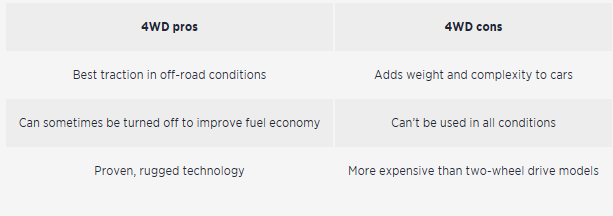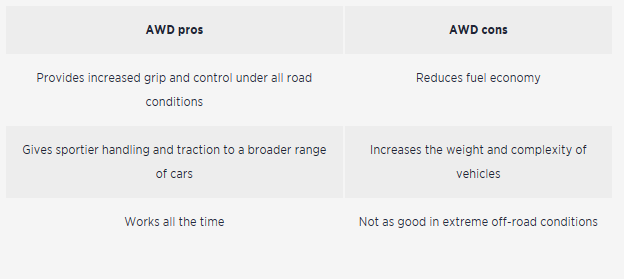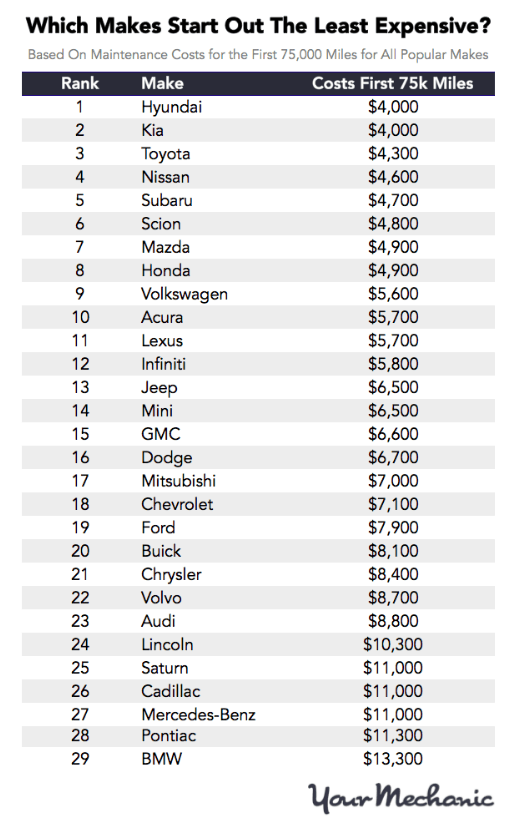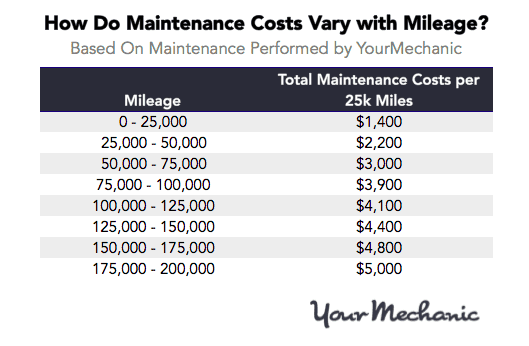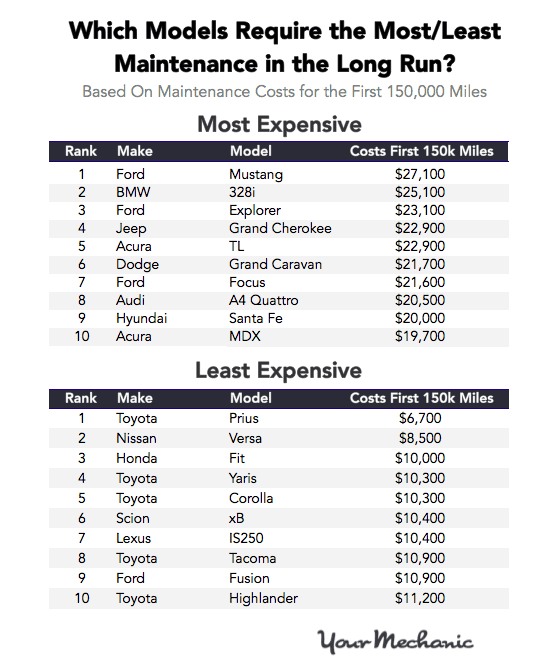-
Posts
161 -
Joined
-
Last visited
-
Days Won
2 -
Carnity Points
22 [ Donate ]
Content Type
Profiles
Forums
Advice
Business Listing
Car Deals
Recall
OBD II Car Diagnostics
Guest lead capture
STORE
Events
Gallery
Blogs
Everything posted by Chirag S.
-
Many large SUVs have 4WD engine but at the same time, gives comfort of family car & glamour e.g. Nissan Patrol, Land Cruiser etc. Giving nice grip to drive on-road & off-road drive to their buyers!!
-
Many AWD systems has reasonably good Horse-Power compared to 4WD i.e. Infinity QX70. Missing elements in AWD like Lower Gear, Diff Locks, Automotive traction, Ground clearance are reasonable factors for not matching off road capability. That make them, more passenger car than off road capability Car.
-
Four-wheel drive (4WD) Let’s start with four-wheel drive. Displayed often as 4WD, and sometimes referred to as four-by-four or 4×4, this system’s main distinction is that it’s typically used on vehicles designed and built to handle the unpaved wilderness. This includes rugged trucks and SUVs such as the Jeep Wrangler, Mercedes-Benz G-Class, and the Toyota Land Cruiser. In a nutshell, it’s a system that sends power to all four wheels equally and without vectoring (controlling the division of power delivery between the wheels or axles), meaning each wheel will spin at the same constant rate as all the others. Power flows from the engine, through the transmission, and normally into a device known as a transfer case that divides it between the front and rear axles. The equal split of power is great for maneuvering through tough and low-traction situations, but it isn’t very friendly on the pavement. Driving a four-wheel drive car on solid ground can make simple actions like turning around in a tight street very difficult, because the wheels are no longer in sync. Most modern 4WD systems are “part-time” and at the flick of a switch four-wheel drive can be engaged Imagine yourself doing a u-turn. In a four-wheel drive car, the inside wheel has to turn more slowly than the outside wheel, which is covering more ground. You might hear a rubbing noise or feel the car hopping when you approach full lock. This is why most 4WD systems are part-time systems that can be disabled. The car operates in two-wheel drive in normal conditions to improve on-road drivability, but still offers four-wheel traction when you need it. What about part-time vs. full-time? Most modern four-wheel drive vehicles are equipped with a part-time system, meaning they operate in two-wheel drive mode in normal driving conditions. The driver can engaged the four-wheel drive system by flicking a switch, pressing a button, or yanking on a center console-mounted lever in low-traction situations. Some 4x4s feature a transfer case with multiple settings, like 4-Low or 4-High. 4-High limits and vectors available power to the wheels so you can move quickly over slippery surfaces (up to about 60 miles per hour). To get the most available power, however, you’ll want 4-Low, which means 4WD with low-range. This low-range gearbox is for low-speed maneuverability, such as rock crawling or getting unstuck, and is only for such conditions. You really don’t want to go too fast in 4WD-Low because things will start breaking, and your trip will start getting expensive. To avoid complexity, a word of advice: You really don’t want to go too fast in 4WD-Low because things will start breaking, and your trip will start getting expensive. Most newer vehicles with part-time systems have an automatic deactivation when the vehicle goes beyond a certain speed to avoid this damage, but older trucks typically do not. Part-time four-wheel drive systems generally feature locking and unlocking differentials. Between each axle sits a differential that compensates for wheels spinning at different rates. By locking a differential at a front or rear axle, you are inhibiting any slip from occurring at the axle, forcing each wheel at said axle to turn at the same rate. Full-time four-wheel drive systems typically don’t come with a two-wheel drive (2WD, or 4×2) mode, so the system is active all the time. It sends power to the four wheels at the same times with limited-slip capabilities. This system is becoming increasingly obsolete, because a part-time system makes more sense for most consumers. Most drivers don’t need four-wheel drive all the time. Older trucks, such as 1990s Toyota Land Cruisers, have full-time systems. They come with an additional center differential to enable limited slip for better drivability on the road, and the system handles power distribution on its own. All-wheel drive (AWD) All-wheel drive is a much more recent innovation, and it’s a little bit more complicated, but also considerably more user-friendly. It crops up on everything from supercars like the Audi R8 to grocery-getters like the Buick Encore. While a four-wheel drive system tries to send as much power to the four wheels as equally as possible for maximum traction, all-wheel drive is all about varying the amount of power sent to each wheel, either mechanically or electronically. Think of all-wheel drive as similar to the part-time four-wheel drive system, except for cars and some crossovers. All-wheel drive is often associated with road-going vehicles, such as sedans, wagons, crossovers, and even some larger SUVs. Crossovers like the Honda CR-V, the Toyota RAV4, andthe Mazda CX-3 tend to fall under the “car” category while SUVs like the Chevrolet Tahoe and the Toyota 4Runner fall under the “truck” category. All-wheel drive is similar to the part-time four-wheel drive system we just described, except it’s used on cars and crossovers. It’s also completely automated. The system is constantly active, and it needs no activation or input from the driver to work. Most newer all-wheel drive systems send power to a primarily axle, either the front or the rear, and transfer power away from the slipping wheels when they detect a loss of traction. This helps improve fuel economy. To quote Subaru’s ad campaign, all-wheel drive “transfers power from the wheels that slip to the wheels that grip.” All-wheel drive is becoming increasingly common in performance applications, too. The Mercedes-AMG E63 is a perfect example. It is now sold only in AWD in the United States because its 600-plus-horsepower output can overwhelm the rear wheels if they try transferring it to the pavement on their own. Even when we aren’t talking about tire-scorching performance cars, splitting power evenly means added stability in all types of weather. All-wheel drive does have some clear advantages over 4WD. AWD isn’t quite as robust as 4WD, and it can’t match the acute power delivery necessary for low-speed off-roading like rock crawling. The maintenance and complexity of these systems can also get extraordinarily expensive, but ensuring they function as intended is crucial to your safety. All-wheel drive does have some clear advantages over 4WD, though. These days, computers are involved in most AWD systems. Sensors on each wheel monitor traction, wheel speed, and several other data points hundreds of times per second. An engine control unit (ECU) analyzes traction conditions and decides which wheel receives power. This type of system, usually called torque vectoring, appears on everything from the Subaru WRX to the Dodge Charger. Torque vectoring has allowed massive improvements in handling and all-weather capability. So, which one do I want? Ultimately, the system you choose largely depends on your driving needs and where you live. Four-wheel drive is your best bet if you plan on using your vehicle off-road and in difficult terrain on a regular basis. It’s normally found on SUVs and pickup trucks that boast the durability to match the ruggedness of a four-wheel drive system. For most people, however, all-wheel drive makes more sense. In the sort of winter road conditions most drivers experience, a modern all-wheel drive system that responds instantly and automatically is good enough. Additionally, all-wheel drive vehicles normally have a better weight distribution, which improves traction and performance. [Courtesy : https://www.digitaltrends.com/cars/awd-vs-4wd/]
-
Many many Happy Returns Of The Day, Happy Birthday 🎉
-
Good Point
-
very nicely elaborated
-
FJC GXR or Extreme: Which is Better Off-Road Car
Chirag S. replied to Chirag S.'s topic in Toyota FJ Cruiser Forum in UAE
Agreed -
Dune Crossing Tutorial and Techniques
Chirag S. replied to Frederic's topic in Off-Road Club's Discussions
Super Wonderful -
Thanks for sharing such a good illustrative video. As a newbie thought; · did not deflate tires properly · did not engage 4L · selecting soft sand route i/o other easy route which other cars were preferred
-
FJC GXR or Extreme: Which is Better Off-Road Car
Chirag S. replied to Chirag S.'s topic in Toyota FJ Cruiser Forum in UAE
I carried KIA Mohave and FJC GXR to sand dunes at AL Awir, but outward view limitation noticed in FJC definitely. Not horrible but comparatively not friendly view . Usually, while driving on familiar dunes or while following caravan, its seems okay to drive any car. This is my personal view. -
FJC GXR or Extreme: Which is Better Off-Road Car
Chirag S. replied to Chirag S.'s topic in Toyota FJ Cruiser Forum in UAE
I think, that is for accessories & all terrain tires and lift body for few inches!! -
Hi Friends, I'd tried to search the conclusion on different search engine towards better off road i..e FJC GXR or Extreme ?!! Off road includes sand dune, mountain safari, beach drives etc. So far as my experience is concern, I am comfortable with GXR as of now!! Awaiting to see the expert advise from you, to enhance my knowledge!! Thanks, Chirag
-
How do I stop my roof rack from whistling?
Chirag S. replied to Chirag S.'s topic in General Discussions
Absolutely right!! -
That is what I thought too. After purchasing that used car under warranty, while trade in with other agency, valuation guy personally informed that car seems accident history. I think, this fact was intentionally hide by used car dealer executive. Also, the same car was under scheme of free insurance and benefit was not passed to me as well. This fact was conveyed by their teammate during trying to resale the same car to them.
- 12 replies
-
- 1
-

-
Yes, it was last year of warranty!
- 12 replies
-
- 1
-

-
How do I stop my roof rack from whistling?
Chirag S. replied to Chirag S.'s topic in General Discussions
Very true!! These noise are expected!! -
How do I stop my roof rack from whistling?
Chirag S. replied to Chirag S.'s topic in General Discussions
One of my known person in Toyota, told me that noise arise due to roof rack!! -
KIA MOHAVE TOP END and dealer is well known in used car nearby Dubai Festival City (I don't know implication of quoting name in this country but name is famous).
- 12 replies
-
- 1
-

-
@Rahimdad rightly said. While trade in my previous car purchased from famous used car dealer in Dubai, dealers reduced 10K straight away than market price on hearing used car dealer name. When I tried to re-sell the same car to the same dealer within purchasing of 5 months, was offering 63% less than price of sold. This mathematics are beyond my imagination.
- 12 replies
-
- 2
-

-

-
How do I stop my roof rack from whistling?
Chirag S. replied to Chirag S.'s topic in General Discussions
@MATHEW FELEX Big thanks for your concern. I will do it!! -
How do I stop my roof rack from whistling?
Chirag S. replied to Chirag S.'s topic in General Discussions
You're right!! -
How do I stop my roof rack from whistling?
Chirag S. replied to Chirag S.'s topic in General Discussions
@MATHEW FELEX Thanks and So helpful!! -
How do I stop my roof rack from whistling?
Chirag S. replied to Chirag S.'s topic in General Discussions
@MATHEW FELEX Nice one!! -
How do I stop my roof rack from whistling?
Chirag S. replied to Chirag S.'s topic in General Discussions
for Roof Top Tent


